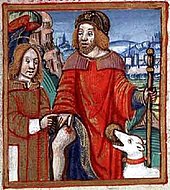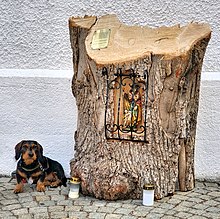Rochus of Montpellier
Rochus von Montpellier (* in Montpellier ; † there, lived according to tradition between 1295 and 1379) is a saint of the Catholic Church who is invoked as the patron saint against the plague . His feast day is August 16 , the traditional day of death.
The Rochus fraternities that arose during the plague were given papal privileges. In some regions the saint is numbered among the fourteen helpers in need. In addition to the plague, he is also called upon as the patron saint of infirmaries and (sick) pets.
Lore

Rochus was born in Montpellier as the son of wealthy parents . After losing his parents at the age of twenty, he gave away his fortune and entered the third order of St. Francis .
As a pilgrim to Rome in 1317, he helped care for plague sufferers on the way. He is said to have healed these miraculously only with the help of the sign of the cross . When he arrived in Rome, he continued to heal without coming to fame or wealth. On his return journey (1322) he fell ill with the plague in Piacenza and was not cared for by anyone; he prayed and retired to a lonely wooden hut in the woods. Legend has it that he was cared for by an angel there , and a junker's dog brought him bread until he was recovered and he could go back to the city, where he continued to heal until he had conquered the plague there.
When he returned to his hometown, no one recognized him because of his scars and blemishes from the plague; so he was thrown in prison on suspicion of espionage. Rochus thanked God for this test and patiently spent five years in prison before he died. After his death he was identified by a cross-shaped mark that he had on his chest since he was born. Much in the life of Saint Roch is considered legendary, the life story was written in Venice in 1478.
Relics
Relics of St. Rochus located since 1485, when she Voghera there transferred were, in the consecrated him church of San Rocco, which for the Scuola Grande di San Rocco belongs in Venice and also under his patronage. On March 13, 1485, the Patriarch of Venice informed the Council of Ten of the authenticity of the relics. Some of the saint's relics were transferred to the Trinitarians' convent in Arles as early as 1372 .
Adoration

Rochus was one of the most popular popular saints in Europe for centuries. As the patron saint of plague sufferers, he enjoyed great popular veneration during the great medieval plague epidemics. After the translation of his relics to Venice and the construction of the Church of San Rocco, pilgrimages led to the tomb of the saint along the trade routes to Venice . In other places in Europe, too, first in southern France and then in the Netherlands, Germany, northern Italy, Poland and Bohemia, chapels and churches consecrated to him were built, to which pilgrimages were made.
The Rochusfriedhof is a church cemetery in the Nuremberg district of Gostenhof with historical and artistically valuable bronze epitaphs as well as culturally significant gravestones and burial places of the Nuremberg population from more than five centuries

Rochus brotherhoods like the Scuola San Rocco or the Rochusbruderschaft in Bingen contributed to the spread of the Rochus cult. In Germany there are churches consecrated to St. Rochus in addition to Bingen in Balkhausen , Bonn-Duisdorf and Düsseldorf , where the veneration of St. Rochus is a centuries-old tradition at the beginning in a chapel and now in the St. Rochus Church Overath- Heiligenhaus in the Archdiocese of Cologne, in Stolberg-Zweifall and in Kämmerzell in the Diocese of Fulda.
Little has survived of the tradition of pilgrimages and processions in honor of the saint and in memory of being saved from the plague. In Germany, however, Rochus pilgrimages still take place in August on the day of remembrance of the saint, as in Lohr am Main on the Valentinusberg, in Großauheim (a district of Hanau) and for over 300 years to renew the Rochus vow in the Rochus Chapel in Olpe in Sauerland. In 2011 the 345th Rochus pilgrimage took place in Bingen am Rhein to Rochusberg. The procession in honor of the saint in Buchen (Odenwald) , which dates back to a vow made in 1635, can be regarded as the oldest still living Rochus tradition in Germany . The Buchen vow was renewed several times (for example on the occasion of a typhus epidemic in 1942/43 or during the corona pandemic 2020) and is celebrated in mid-July.
The veneration of Saint Roch is also widespread in Croatia - e.g. B. on the island of Murter there is a mountain church dedicated to the saint. There you can also see a representation of the church patron. It is believed that the worship was widespread in Dalmatia during the Venetian rule.
The saint was also very popular in Vienna . In the 3rd district of Vienna Landstrasse there is a Rochusplatz, a Rochusgasse, a Rochusmarkt and a Rochuskirche . In Cologne-Ossendorf there is both Rochus Park and Rochusstraße at the local Diakonie as well as the (meanwhile desecrated) Holy Trinity Church.
The worship of San Roque in the Bolivian city of Tarija is of exceptional importance . Every year several thousand so-called chunchos promesantes in ornate penitential garb with fixed choreography through the streets of the city, from church to church. The grand finale is the Fiesta Grande de Tarija , when everyone gathers singing in front of the church dedicated to the saint ( Iglesia San Roque ), accompanied by traditional music and bells ringing. It's the highlight of the city's festival calendar, with a tradition that dates back to 1863. With this annually repeated ritual, the men fulfill a promise from which they hope for a miraculous cure for an illness of themselves or a loved one.
iconography
The oldest representations of the saint go back to 1430. Saint Roch is represented with the following attributes :
- Plague mark on the thigh, which he indicates by bare
- Dog bringing bread
- as a pilgrim with a shell hat and a pilgrim's staff
- less often in the company of an angel who brings him a vessel of ointment
St. Rochus as patron saint against the plague, painting by M. Heymans in Oss (Netherlands) , 1903
St. Rochus at the Mariensäule ( plague column ) in Šternberk , Czech Republic, 18th century
Rochus Chapel in Bingen, the saint with the angel on the gable, 19th century
See also
- Glory of St. Rochus of Montpellier
- Rochus Church
- St. Rochus Hospital
- Cape St. Roch , Brazil
literature
- Barbara Fleith: Rochus. In: Author's Lexicon . 2nd Edition. Volume 8, Col. 118-121.
- Peter Dinzelbacher : Rochus. In: Werner E. Gerabek , Bernhard D. Haage, Gundolf Keil , Wolfgang Wegner (eds.): Enzyklopädie Medizingeschichte. De Gruyter, Berlin / New York 2005, ISBN 3-11-015714-4 , p. 1256.
- Paolo Ascagni, Nicola Montesano: San Rocco di Montpellier. Studi e ricerche. Editione CSDS, Tolve 2015.
- Michael Zeller : Rochus. The plague and its patron. Nuremberg 1989.
- Norbert Angermann u. a. in: Lexicon of the Middle Ages . Munich 2002, Volume 7, Col. 926.
Web links
Individual evidence
- ↑ Saint Roch, his life, the transfer to Venice ( Memento of the original from January 5, 2015 in the Internet Archive ) Info: The archive link was inserted automatically and has not yet been checked. Please check the original and archive link according to the instructions and then remove this notice. , scuolagrandesanrocco.it (English)
- ↑ See also San Rocco di Montpellier .
- ↑ Plague chapels and plague crosses (Rochuskapellen, Sankt Rochus Kapellen) . In: Kultur.Landschaft.Digital. (accessed January 21, 2019).
- ↑ Book: The vow has not lost its relevance. Retrieved July 20, 2020 .
- ↑ Recording of the service in honor of St. Roch in Buchen on July 19, 2020. Catholic pastoral care unit in Buchen, July 19, 2020, accessed on July 20, 2020 .
- ^ A b Rochus von Montpellier in the Ecumenical Lexicon of Saints
| personal data | |
|---|---|
| SURNAME | Rochus of Montpellier |
| BRIEF DESCRIPTION | Saint, patron saint of plague sufferers and domestic animals |
| DATE OF BIRTH | 12th century or 13th century |
| PLACE OF BIRTH | Montpellier |
| DATE OF DEATH | 14th Century |
| Place of death | Montpellier |






